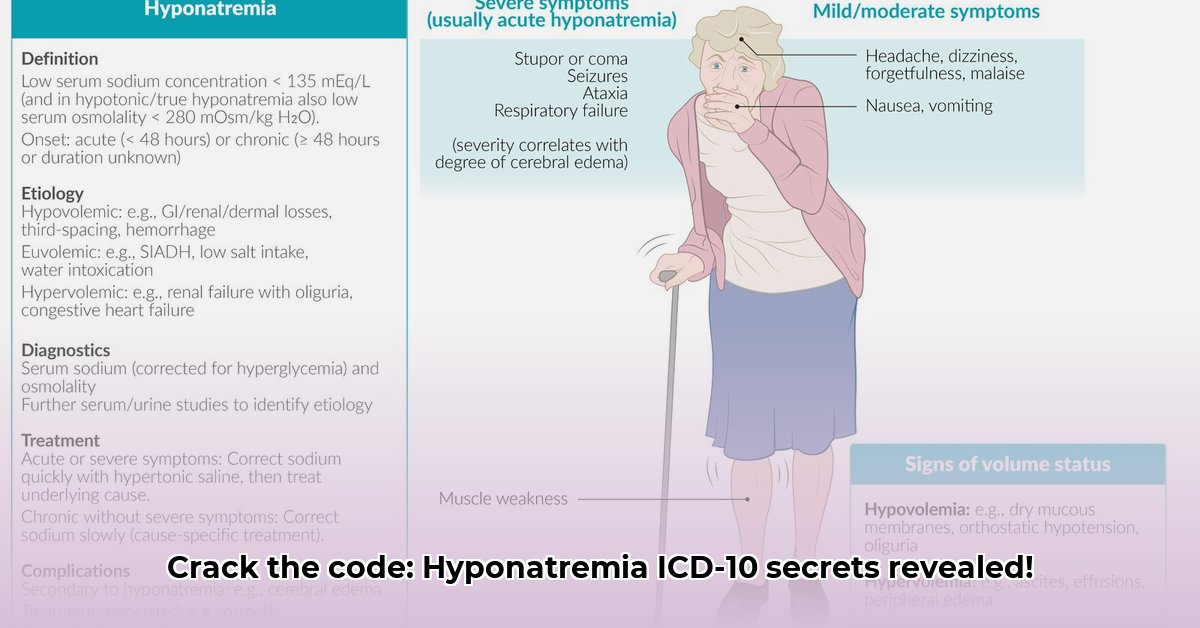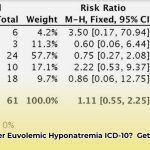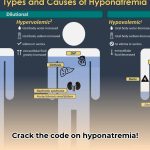Navigating the ICD-10 system for hypovolemic hyponatremia can be challenging. This guide provides a step-by-step approach, equipping you with the knowledge to avoid common and costly errors. We’ll explore the nuances of hyponatremia types, detail essential documentation practices for accurate coding, and highlight frequent pitfalls to watch out for. Whether you are an experienced medical coder or new to the field, this guide will empower you to confidently and accurately code hyponatremia, ensuring appropriate billing and contributing to enhanced patient care. For further ICD-10 guidance, see this helpful resource: ICD-10 Hyponatremia Guide.
Hypovolemic Hyponatremia ICD-10: Mastering the Code
A solid understanding of hyponatremia coding is essential for proper billing practices and high-quality patient care. This guide delivers a clear, step-by-step walkthrough to master hypovolemic hyponatremia and its specific ICD-10 code (International Classification of Diseases, Tenth Revision). Addressing these complexities ensures not only accurate financial processes but also the delivery of optimal healthcare.
Understanding ICD-10 Code E87.1: More Than Meets the Eye
The ICD-10 code E87.1, “Hypo-osmolality and hyponatremia,” represents a broad category for low sodium levels in the blood. It serves as a comprehensive umbrella encompassing various underlying causes, underscoring the importance of identifying the specific type of hyponatremia for accurate coding.
Consider these key points regarding the use of E87.1:
- E87.1 necessitates specific differentiations to reflect the diverse underlying causes of low sodium.
- Accurate coding requires pinpointing the precise type of hyponatremia.
- Correct coding extends beyond mere numbers, directly impacting patient care quality.
Three Types of Low Sodium: Spotting the Differences
Hyponatremia presents in several forms, each with distinct causes and coding implications. Doctors categorize it into three main types, and understanding these differences is critical for correct coding:
- Hypovolemic Hyponatremia: This occurs when the body loses both water and sodium simultaneously, often due to factors like vomiting, diarrhea, or excessive sweating. In these cases, the E87.1 code applies, with careful documentation of the specific cause of fluid loss.
- Euvolemic Hyponatremia: In this condition, the total amount of fluid in the body remains normal, but the sodium level is low due to imbalances in water regulation, such as Syndrome of Inappropriate Antidiuretic Hormone Secretion (SIADH). Coding for euvolemic hyponatremia often involves ICD-10 codes distinct from E87.1, depending on the underlying cause.
- Hypervolemic Hyponatremia: This type involves an overall increase in body fluid volume, but the sodium level is diluted. It is commonly observed in individuals with underlying conditions such as heart failure or kidney problems, frequently requiring different ICD-10 codes to reflect the primary condition.
Accurate Documentation: The Key to Correct Coding
Accurate coding hinges on clear and detailed medical records, which prevent billing discrepancies and promote better patient outcomes. Thorough documentation of patient symptoms, medical history, physical examination findings, and laboratory results is critical.
To ensure precision, focus on including these essential details:
- Comprehensive Patient History: Provide a detailed description of the patient’s presenting symptoms, relevant medical history, and pertinent physical examination results. Document the frequency, severity, and duration of related factors, such as the frequency and volume of vomiting or diarrhea.
- Laboratory Results Narrative: Record all relevant laboratory results, including serum sodium levels, serum osmolality (concentration of dissolved particles in the serum), and urine sodium levels. Use these values as diagnostic indicators to accurately identify the specific type of hyponatremia present.
- Etiology Identification: Clearly identify the underlying cause of the patient’s hypovolemia. This requires noting causative factors such as profuse sweating, severe diarrhea, diuretic medication use, or other relevant conditions. Determining the root cause of hyponatremia is crucial for accurate coding and treatment planning.
- Treatment and Response: Document all treatments administered and the patient’s response to these interventions. Provide contextual information that completes the clinical narrative, facilitating a comprehensive understanding of the patient’s clinical course.
Good Documentation Example: “A 70-year-old female presented with a three-day history of severe diarrhea and vomiting, resulting in significant dehydration and hypovolemic hyponatremia (serum sodium 125 mmol/L). Intravenous normal saline was administered, leading to a gradual improvement in her sodium levels, with serum sodium increasing to 132 mmol/L by the following day.” This example demonstrates a clear link between symptoms, laboratory findings, and treatment outcomes.
Poor Documentation Example: “Low sodium.” This is excessively vague and lacks essential information regarding the etiology, severity, or treatment of the hyponatremia, rendering it insufficient for accurate coding.
Coding Strategies: Putting It All Together
Coding hypovolemic hyponatremia often requires the use of more than just the E87.1 code. Additional codes are typically needed to specify the underlying cause of the condition, such as dehydration, diarrhea, or other contributing factors. Always prioritize adherence to the latest ICD-10 guidelines and official coding manuals to ensure coding accuracy and compliance.
Common Coding Errors and How to Avoid Them
Coding errors frequently arise from inadequate documentation or the failure to accurately identify the specific type of hyponatremia. These errors can be addressed by meticulously reviewing patient records to develop a thorough understanding of the clinical picture and accurately classifying the type of hyponatremia present. Regular training sessions and access to the latest coding resources are crucial for minimizing errors and optimizing coding accuracy.
Compliance and Potential Penalties
Inaccurate coding can lead to audits, fines, and reimbursement denials. Accurate coding is essential to protect both healthcare practices and patients from potential financial and legal repercussions. Compliance with regulatory guidelines is paramount for all medical coding activities.
Staying Up-to-Date
The medical field is continuously evolving, making it crucial to stay updated with the latest information from official medical coding resources and professional medical society guidelines. Regular review of coding updates and participation in continuing education activities are integral to maintaining coding proficiency and ensuring compliance with current standards.
Mastering hypovolemic hyponatremia ICD-10 coding demands precision and a keen attention to detail. Accurate coding is not only essential for ensuring appropriate reimbursement but also pivotal for delivering high-quality patient care, maintaining regulatory compliance, and developing valuable professional skills.
How to Accurately Code ICD-10 E87.1 Hyponatremia for Optimal Reimbursement
A deep understanding of hyponatremia subtypes enhances coding efficiency, enabling you to achieve optimal reimbursements through accurate application of ICD-10 E87.1.
Key Takeaways:
- The accuracy of coding E87.1 depends on thorough, detailed documentation that connects low sodium levels, presenting symptoms, and the underlying causes of the condition.
- Differentiating between acute and chronic hyponatremia is critical for selecting the appropriate code and ensuring accurate reimbursement.
- To comprehensively capture all relevant aspects of a patient’s condition, additional codes may be required to document co-existing conditions and related symptoms fully.
Understanding Hyponatremia and ICD-10 E87.1
Hyponatremia, defined as low sodium levels in the blood, is specifically addressed by the ICD-10-CM code E87.1. Accurate coding is crucial, as inaccuracies can lead to claim denials and financial difficulties for healthcare providers.
Differentiating Hyponatremia Types: A Crucial Step
Understanding the different subtypes of hyponatremia is essential.
- Hypovolemic Hyponatremia: Occurs when both sodium and fluid are lost from the body, often due to diarrhea, vomiting, or excessive sweating, resulting in overall volume depletion.
- Euvolemic Hyponatremia: Characterized by low sodium levels despite a normal total body fluid volume, often stemming from conditions such as SIADH (Syndrome of Inappropriate Antidiuretic Hormone).
- Hypervolemic Hyponatremia: Involves an excess of fluid in the body combined with low sodium levels, typically seen in cases of heart failure or kidney failure.
Accurate Documentation: The Foundation of Correct Coding
Accurate and precise documentation is critical for accurate ICD-10 coding and optimal reimbursement. This necessitates including:
- Serum Sodium Levels: Include the exact serum sodium level, measured in mmol/L, which confirms the presence of hyponatremia when the level is below 135 mmol/L.
- Symptoms: Thoroughly document all presenting symptoms, such as confusion, nausea, seizures, or subtle cognitive changes. Document the severity and impact of each symptom to provide a comprehensive clinical picture.
- Underlying Cause: Identify and document the root cause of hyponatremia, whether it is dehydration, medication side effects, or other underlying medical conditions. Thoroughly document the specific mechanisms leading to fluid loss, which is particularly vital for hypovolemic hyponatremia.
- Acute vs. Chronic Differentiation: Clearly differentiate between acute and chronic hyponatremia, as the acuity of onset can significantly influence treatment decisions and coding accuracy. Document the timeframe over which the hyponatremia developed to support accurate coding and clinical management.
Coding Strategies and Best Practices
E87.1
- Wellness Fair Ideas for Work to Boost Employee Wellbeing - December 15, 2025
- Affordable Employee Wellness Fair Ideas for Any Budget - December 14, 2025
- Employee Wellness Programs Strategically Benefit Employee Health And Retention - December 13, 2025
















